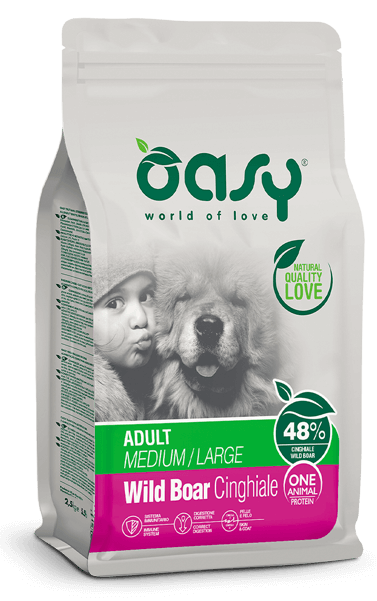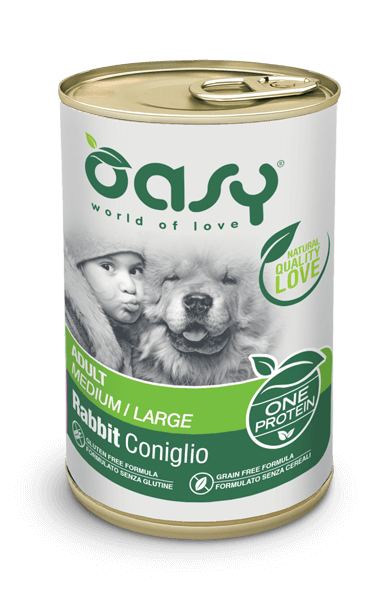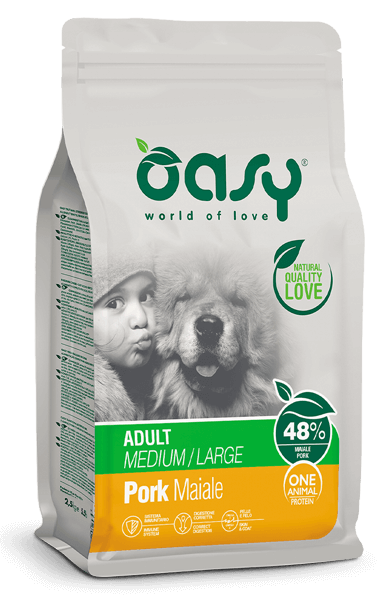Dermatits in dogs can be caused by multiple factors: find out all the causes, symptoms and how nutrition can help them.
When dogs scratch themselves often it may look like normal behavior, but if it becomes
too frequent and excessive it may signal a problem such as
dermatitis caused by a sensitivity, and that should not be underestimated.
Dermatitis is one of
dogs’ most common skin conditions and can appear at any age, with higher frequency in genetically predisposed breeds.
Identifying the symptoms and
understanding why the dog is scratching is the first step to relieve the discomfort, protect their health and bring serenity back to your daily life.
In this article we will try and
understand what dermatitis is, and how in some cases,
nutrition can be the best answer to manage this problem.
What does dermatitis in dogs look like?
Dogs’ dermatitis is a
common skin condition, that appears as
an inflammation of the skin. It cannot be considered as a single disease. This term includes in fact
various disorders with different causes and characteristics. Among the main types we can find:
- Allergic dermatitis: it develops when the dog reacts abnormally to some substance in the environment, such as pollen, dust, mites or flea bites. The body interprets these stimuli as a threat and starts an inflammatory response that causes intense itching, which is difficult for the dog to ignore.
- Stress-induced dermatitis: in some cases, dogs that are particularly anxious, lonely or excessively bored can develop repetitive behaviors like compulsive licking or scratching. Over time, these actions can lead to skin lesions that must be treated in a targeted way.
- Canine atopic dermatitis: it indicates a chronic inflammatory disease due to an altered response of the immune system. It is often hereditary, that’s why some breeds (such as Labradors or Bulldogs) are more predisposed than others. In these cases, it can be managed with specific treatments and with a careful food choice, to alleviate the itching and improve the quality of life of the affected dog.
Identifying the type is the first thing to do to start the right treatment and
not confuse a temporary disease with a chronic condition.
Symptoms of dermatitis
Itching is certainly
the clearest symptom of dermatitis, and it can go from occasional discomfort to a
continuous and persistent problem.
A
dog that frequently scratches, licks or bites some body areas is trying to express a discomfort that must be noticed. Besides itching, other typical signals can appear:
- Skin irritation or redness, often located in spots like paws, belly or ears.
- Hair loss in the most affected areas, with visible spots.
- Scabs or small wounds, caused by excessive scratching or licking.
- Skin changes and may become dry and flaky or greasy and oily.
- In some cases, unpleasant odors can also develop due to wounds getting infected.
If we wonder
why the dog keeps scratching, it is important not to rely on a simple hypothesis but to request the help of a professional. A visit to the vet is fundamental to have a
correct diagnosis. The vet can in fact
perform skin tests, blood tests and collect
skin samples to
identify the source of the issue and decide the most appropriate treatment, which may include topical treatments or supplements.
Together with professional help,
nutrition also plays a
fundamental role in both daily management of the symptoms and prevention. A
diet based on the dog’s needs, especially in case of
sensitivity or
intolerance, can really make a difference over time. In the next paragraph we’ll see why.
Food intolerances as a cause of dermatitis
Food intolerances are
among the most frequent causes of food-related allergic dermatitis. In these cases, it is not just a “digestive problem”: when the body can't tolerate a particular ingredient included in food, it can trigger a reaction that occurs with
itching, redness, hair loss and, sometimes, even gastrointestinal discomforts such as vomiting and diarrhoea. That’s why a
diet with an
excessive amount of inappropriate ingredients, or that is formulated with
multiple sources of animal proteins can increase the risk of skin reactions, stimulate itching and promote inflammatory processes, making it more difficult to identify the source of the problem.
To understand if the dog’s dermatitis is related to diet, it takes
time, patience and a plan agreed with the vet, who may suggest an
exclusion protocol: certain ingredients get gradually eliminated from the dog's diet until it is possible to identify which one is triggering the allergic reaction. This process requires constancy, but it can bring important and long-lasting improvements. In the next paragraph we will see why.
Prevention and useful tips: the importance of nutrition.
First,
preventing dermatitis in dogs means minimizing the triggering causes. Correct hygiene, regular veterinary check-ups and good management of the environment are fundamental aspects,
but daily nutrition often represents a key factor.
A
single-protein diet involves just
one source of animal protein and is considered one of the most effective methods. This choice
simplifies the dog’s diet and helps to significantly reduce the risk of reactions. It also makes it easier to identify problematic ingredients, as it eliminates complex formulations with multiple different proteins.
This kind of diet can
help alleviate the itch and other
skin-related symptoms linked to intolerances, and it is also useful to improve digestion, strengthen immune system and keep your dog in good shape over time. This is a
particularly appropriate method for dogs with genetic predisposition to dermatitis or for those that have already showed symptoms of
food sensitivity.
In this way, the dog’s daily meal is no longer a risk factor and becomes a tool for prevention instead, which can support healthy skin, coat and more generally, the quality of life of our four-legged friends.
The Oasy One Animal Protein offer
At Oasy, we perfectly know the
importance of nutrition in dogs’ daily wellbeing, especially when
dermatitis, intolerances and skin sensitivities are involved.
This is why, for
particularly delicate dogs, we developed the One Animal Protein range. It is available both in dry version with
mono protein kibbles, and in
wet version. These are the main characteristics:
- Single protein formulas, with just one source of animal protein to simplify the dog’s diet.
- Selected ingredients, which guarantee a safe, balanced and complete nutrition.
- A balanced intake of Omega-6 and -3 fatty acids, to promote healthy skin and shiny coat.
- A variety of flavours, to adapt to the dog’s preferences and specific needs, without compromising on quality.
Completing the dog’s daily diet with carefully selected products not only helps to
alleviate the itch and improve
skin’s health but also supports the growth of a shiny and healthy coat. The
single-protein diet represents a concrete strategy to improve our dogs’ general wellbeing, restoring their energy, vitality and giving them all the comfort they deserve.


